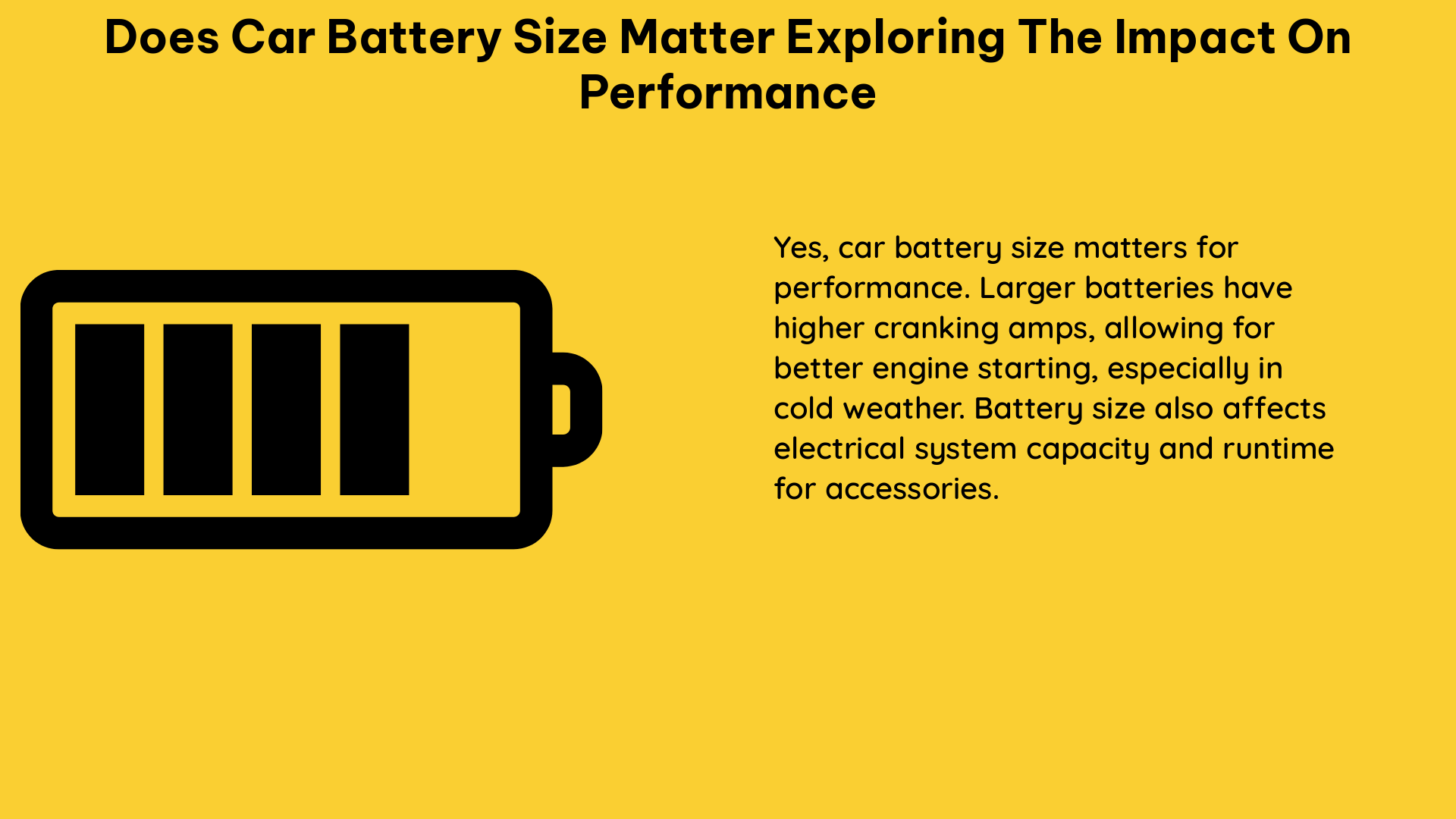The size of a car battery can have a significant impact on the performance and compatibility of your vehicle. The battery size affects the voltage, capacity, and cold cranking amps (CCA), which are crucial factors in determining the overall performance and reliability of your car’s electrical system. Understanding the importance of battery size and its implications is essential for maintaining optimal vehicle performance.
Voltage and Capacity: The Backbone of Battery Performance
The voltage of a car battery is typically 12 volts, which is the standard for most modern vehicles. However, the capacity of the battery, measured in amp-hours (Ah), can vary depending on the size and design of the battery. A higher capacity battery will have a longer runtime before needing a recharge, providing more consistent power to the vehicle’s electrical components.
| Battery Capacity | Typical Usage |
|---|---|
| 40-60 Ah | Compact and subcompact cars |
| 60-80 Ah | Midsize and full-size cars |
| 80-100 Ah | Trucks, SUVs, and high-performance vehicles |
It’s important to note that using a battery with a higher capacity than the manufacturer’s recommendation is generally safe and won’t harm your vehicle. However, using a battery with a lower capacity can lead to issues, such as insufficient cranking power, especially in cold weather conditions.
Cold Cranking Amps (CCA): The Lifeblood of Engine Startup

Cold Cranking Amps (CCA) is a crucial specification that measures a battery’s ability to start an engine in cold temperatures. The higher the CCA rating, the more power the battery can deliver to the starter motor, ensuring a reliable engine startup even in frigid conditions.
| CCA Rating | Typical Usage |
|---|---|
| 300-500 CCA | Compact and subcompact cars |
| 500-700 CCA | Midsize and full-size cars |
| 700-900 CCA | Trucks, SUVs, and high-performance vehicles |
Using a battery with a higher CCA rating than the manufacturer’s recommendation is generally safe and won’t harm your vehicle. However, using a battery with a lower CCA rating can impact cold cranking, as there may not be enough stored energy to turn over the engine in cold weather.
BCI Group Size: The Key to Compatibility
The Battery Council International (BCI) Group Size is a standardized system that indicates the precise physical dimensions of a battery, including its length, width, height, and terminal configuration. This information is crucial for ensuring the battery’s compatibility with your vehicle’s battery tray and electrical system.
Selecting a battery with the correct BCI Group Size is essential to avoid fitment issues, such as poor physical fit, contact with the hood, incorrect terminal design, and potential damage to the vehicle’s electronics. It’s recommended to use the same or higher BCI Group Size as the original battery installed in your vehicle.
Terminal Configuration and Battery Chemistry
In addition to the BCI Group Size, the terminal configuration and battery chemistry are also important factors to consider when selecting a replacement battery.
Terminal configuration refers to the orientation and type of terminals (top-post or side-post) on the battery. Ensuring the correct terminal configuration is crucial for proper connection and integration with your vehicle’s electrical system.
Battery chemistry, on the other hand, determines the overall performance and lifespan of the battery. The most common types of car batteries are lead-acid (flooded, AGM, and gel) and lithium-ion. Each chemistry has its own advantages and disadvantages, so it’s essential to choose a battery that matches your vehicle’s requirements and driving conditions.
Consequences of Using the Wrong Battery Size
Using a battery that is too small or too large for your vehicle can lead to a variety of issues, including:
- Fitment Problems: A battery that is too small or too large may not fit properly in the battery tray, leading to poor physical fit, contact with the hood, or difficulty securing the battery in place.
- Insufficient Cranking Amperage: A battery with a lower CCA rating than recommended can struggle to provide enough power to the starter motor, especially in cold weather, resulting in difficulty starting the engine.
- Damage to Electrical Components: A battery that is too large may come into contact with other components, potentially causing damage to the vehicle’s electronics or wiring.
- Shortened Battery Life: Using a battery that is not compatible with your vehicle’s electrical system can lead to premature battery failure and reduced lifespan.
Conclusion
In conclusion, the size of a car battery does matter and can significantly impact the performance and compatibility of your vehicle. By understanding the importance of voltage, capacity, CCA, BCI Group Size, terminal configuration, and battery chemistry, you can ensure that you select the right replacement battery for your car, truck, or SUV. This will not only maintain optimal vehicle performance but also extend the lifespan of your battery and protect your vehicle’s electrical system.
Reference:
- Using the Wrong Battery Can Damage Your Car
- Does Car Battery Size Matter?
- Battery Sizes & Battery Group Sizes

The lambdageeks.com Core SME Team is a group of experienced subject matter experts from diverse scientific and technical fields including Physics, Chemistry, Technology,Electronics & Electrical Engineering, Automotive, Mechanical Engineering. Our team collaborates to create high-quality, well-researched articles on a wide range of science and technology topics for the lambdageeks.com website.
All Our Senior SME are having more than 7 Years of experience in the respective fields . They are either Working Industry Professionals or assocaited With different Universities. Refer Our Authors Page to get to know About our Core SMEs.